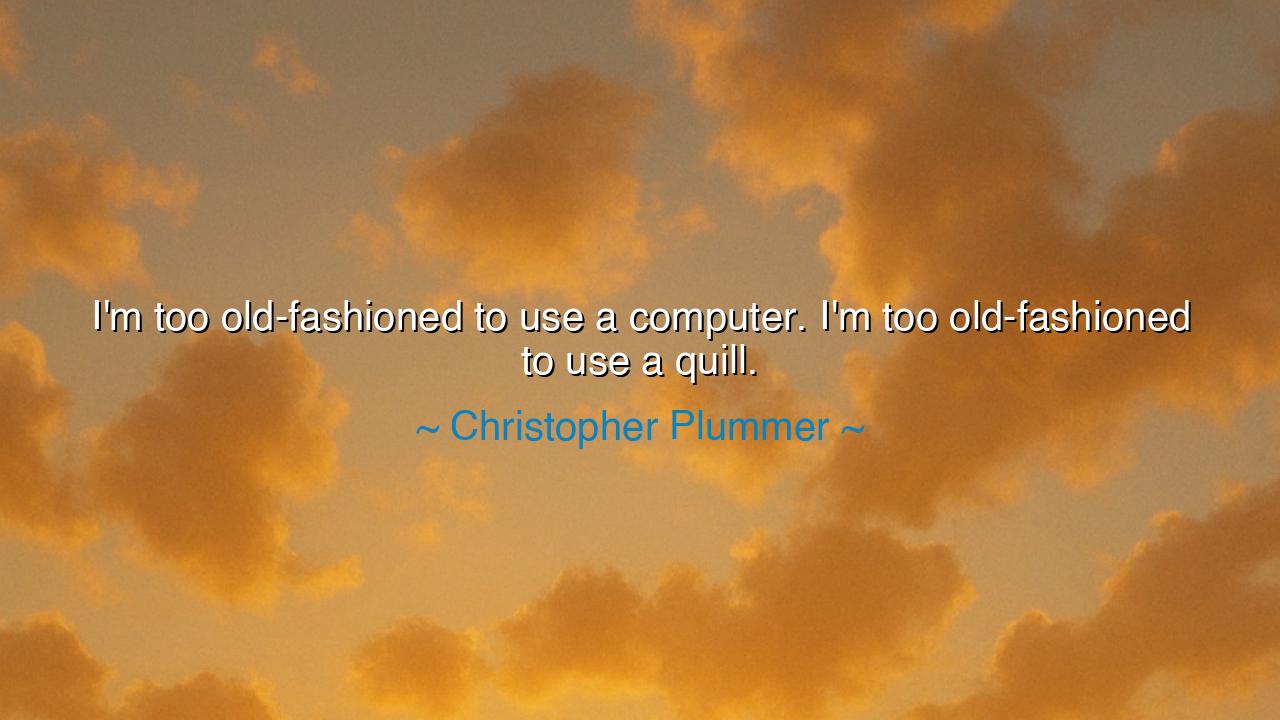
I'm too old-fashioned to use a computer. I'm too old-fashioned to






In the swift currents of time, there are moments when the pace of change seems so rapid that even the most advanced minds are left struggling to keep up. Christopher Plummer's words, "I'm too old-fashioned to use a computer. I'm too old-fashioned to use a quill," speak to this timeless struggle between tradition and innovation. His statement, though humorous in its paradox, touches upon a deeper tension within the human experience—the tension between embracing the future and honoring the past. Plummer’s words remind us of a profound truth: as the world moves forward, it often leaves behind those who are bound by older ways, yet it also carries with it the wisdom of those who have experienced the world in a different way.
In ancient times, there was a similar discomfort with the new. Socrates, the great Greek philosopher, famously distrusted the written word, believing that writing would erode the memory and wisdom that oral traditions carried. He feared that as new tools like writing came into play, they would strip away the depth of human connection and understanding. Much like Plummer's rejection of both the computer and the quill, Socrates saw the evolution of tools not as a means to advance the soul, but as something that could potentially deaden the deeper aspects of humanity. Plummer’s words echo this discomfort with change, highlighting the tension between preserving the old ways and embracing the new.
Similarly, Leonardo da Vinci, the brilliant polymath of the Renaissance, was a man caught between the past and the future. Though Leonardo was one of the greatest innovators of his time, designing inventions and machines that were centuries ahead of their time, he was also deeply rooted in the traditions of art and anatomy that came before him. Like Plummer, da Vinci often found himself both embracing the new world and holding onto the old—painting and drawing with the tools of the past, even as he conceptualized machines and inventions that would eventually shape the future. The conflict between tradition and innovation is a constant thread in human history, a struggle that reflects the delicate balance between honoring the past and progressing into the unknown.
In the modern era, the rise of the computer represents the ultimate symbol of this shift. The machine has transformed the way we think, work, and communicate, replacing manual methods with electronic ones. Yet, for many, this transformation feels alienating. The computer, much like the quill before it, stands as both a tool and a symbol of progress, a reminder that the world is constantly evolving. But as Plummer suggests, this progress often comes with a sense of loss, as if the tools we once held dear—the quill, the typewriter, the handwritten letter—are being swept aside in favor of something faster, more efficient, but perhaps less personal.
The lesson in Plummer’s words is one of reflection. As we move further into the digital age, it is easy to become consumed by the speed and efficiency of new technologies. But Plummer's rejection of both the computer and the quill urges us to pause and consider what we may be losing in the process. The tools we use shape our experience of the world, and as we replace the old with the new, we must ask ourselves whether we are gaining progress or simply sacrificing something deeper. Plummer's lament is not just about rejecting new technology; it is about recognizing the value in what is ancient and enduring, even as we embrace the future.
In practical terms, this means that we must not allow the rush of progress to eclipse our connection to the past. While it is essential to embrace new technologies and the innovations they bring, we must also remain rooted in the timeless values that shape our humanity—thoughtfulness, reflection, and meaningful communication. The computer may offer efficiency, but the quill offers something that machines cannot replicate: the human touch, the personal connection that comes from the act of writing by hand, of creating something with patience and intention. Just as Leonardo da Vinci found inspiration in the traditions of his time, we too can find wisdom in the tools of the past, even as we look to the future.
Ultimately, Plummer’s words remind us that balance is key. The past and the future are not mutually exclusive, but are part of a continuum that defines who we are and who we will become. Just as Socrates questioned the impact of writing on human memory, and Leonardo embraced both the old and the new, we must navigate the digital age with both caution and courage. We must use technology not to replace the deep, human connections we hold dear, but to enhance and enrich them. The true power of the future lies in our ability to honor the wisdom of the past while boldly creating the future we wish to see. Let us, then, take Plummer’s words to heart—recognizing that in every new tool, there is the potential for both disruption and growth, and that the challenge is not in rejecting the new, but in embracing it while maintaining the richness of the old.






AAdministratorAdministrator
Welcome, honored guests. Please leave a comment, we will respond soon